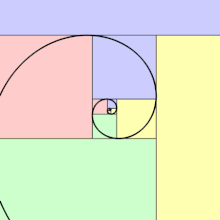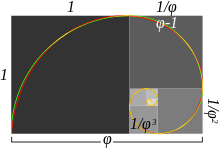Golden spiral

In geometry, a golden spiral is a logarithmic spiral whose growth factor is φ, the golden ratio.[1] That is, a golden spiral gets wider (or further from its origin) by a factor of φ for every quarter turn it makes.
Approximations of the golden spiral

There are several comparable spirals that approximate, but do not exactly equal, a golden spiral.[2]
For example, a golden spiral can be approximated by first starting with a rectangle for which the ratio between its length and width is the golden ratio. This rectangle can then be partitioned into a square and a similar rectangle and this newest rectangle can then be split in the same way. After continuing this process for an arbitrary number of steps, the result will be an almost complete partitioning of the rectangle into squares. The corners of these squares can be connected by quarter-circles. The result, though not a true logarithmic spiral, closely approximates a golden spiral.[2]
Another approximation is a Fibonacci spiral, which is constructed slightly differently. A Fibonacci spiral starts with a rectangle partitioned into 2 squares. In each step, a square the length of the rectangle's longest side is added to the rectangle. Since the ratio between consecutive Fibonacci numbers approaches the golden ratio as the Fibonacci numbers approach infinity, so too does this spiral get more similar to the previous approximation the more squares are added, as illustrated by the image.
Spirals in nature
Approximate logarithmic spirals can occur in nature, for example the arms of spiral galaxies[3] - golden spirals are one special case of these logarithmic spirals, although there is no evidence that there is any general tendency towards this case appearing. Phyllotaxis is connected with the golden ratio because it involves successive leaves or petals being separated by the golden angle; it also results in the emergence of spirals, although again none of them are (necessarily) golden spirals. It is sometimes stated that spiral galaxies and nautilus shells get wider in the pattern of a golden spiral, and hence are related to both φ and the Fibonacci series.[4] In truth, spiral galaxies and nautilus shells (and many mollusk shells) exhibit logarithmic spiral growth, but at a variety of angles usually distinctly different from that of the golden spiral.[5][6][7] This pattern allows the organism to grow without changing shape.[citation needed]
Mathematics

A golden spiral with initial radius 1 is the locus of points of polar coordinates satisfying
The polar equation for a golden spiral is the same as for other logarithmic spirals, but with a special value of the growth factor b:[8]
or
with e being the base of natural logarithms, a being the initial radius of the spiral, and b such that when θ is a right angle (a quarter turn in either direction):
Therefore, b is given by

The numerical value of b depends on whether the right angle is measured as 90 degrees or as radians; and since the angle can be in either direction, it is easiest to write the formula for the absolute value of (that is, b can also be the negative of this value):
- for θ in degrees;
An alternate formula for a logarithmic and golden spiral is:[9]
where the constant c is given by:
which for the golden spiral gives c values of:
if θ is measured in degrees, and
if θ is measured in radians.
With respect to logarithmic spirals the golden spiral has the distinguishing property that for four collinear spiral points A, B, C, D belonging to arguments θ, θ + π, θ + 2π, θ + 3π the point C is the projective harmonic conjugate of B with respect to A, D, i.e. the cross ratio (A,D;B,C) has the singular value −1. The golden spiral is the only logarithmic spiral with (A,D;B,C) = (A,D;C,B).
Polar slope

In the polar equation for a logarithmic spiral:
the parameter b is related to the polar slope angle :
- .
In a golden spiral, being constant and equal to (for θ in radians, as defined above), the slope angle is:
- , hence:
- if measured in degrees, or
- (in radians), or
- (in degrees)
is the angle the golden spiral arms make with a line from the center of the spiral.
See also

References
- ^ Chang, Yu-sung, "Golden Spiral Archived 2019-07-28 at the Wayback Machine", The Wolfram Demonstrations Project.
- ^ a b Madden, Charles B. (2005) [1999]. Fib and Phi in Music: The Golden Proportion Musical Form. High Art Press. pp. 14–16. ISBN 978-0967172767.
- ^ Midhat Gazale (1999). Gnomon: From Pharaohs to Fractals. Princeton University Press. p. 3. ISBN 9780691005140.
- ^ For example, these books: Jan C. A. Boeyens (2009). Chemistry from First Principles. Springer. p. 261. ISBN 9781402085451., P D Frey (2011). Borderlines of Identity: A Psychologist's Personal Exploration. Xlibris Corporation. ISBN 9781465355850.[self-published source], Russell Howell and James Bradley (2011). Mathematics Through the Eyes of Faith. HarperCollins. p. 162. ISBN 978-0062024473., Charles Seife (2000). Zero: The Biography of a Dangerous Idea. Penguin. p. 40. ISBN 978-0140296471., Sandra Kynes (2008). Sea Magic: Connecting With the Ocean's Energy. Llewellyn Worldwide. p. 100. ISBN 9780738713533., Bruce Burger (1998). Esoteric Anatomy: The Body as Consciousness. North Atlantic Books. p. 144. ISBN 9781556432248.
- ^ David Darling (2004). The Universal Book of Mathematics: From Abracadabra to Zeno's Paradoxes. John Wiley & Sons. p. 188. ISBN 9780471270478.
- ^ Devlin, Keith (May 2007). "The myth that will not go away".
- ^ Peterson, Ivars (2005-04-01). "Sea Shell Spirals". Science News. Society for Science & the Public.
- ^ Priya Hemenway (2005). Divine Proportion: Φ Phi in Art, Nature, and Science. Sterling Publishing Co. pp. 127–129. ISBN 1-4027-3522-7.
- ^ Klaus Mainzer (1996). Symmetries of Nature: A Handbook for Philosophy of Nature and Science. Walter de Gruyter. pp. 45, 199–200. ISBN 3-11-012990-6.
























